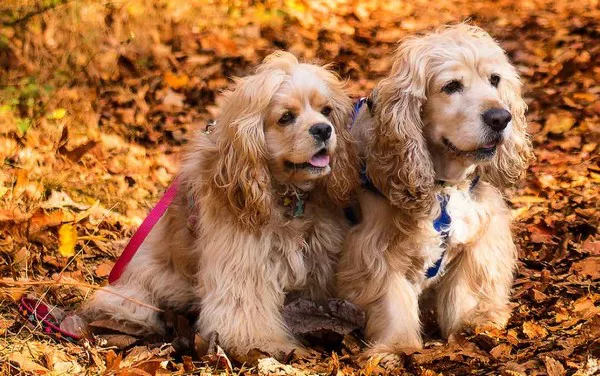Cocker Spaniels, with their expressive eyes and affectionate nature, have long captured the hearts of dog lovers. One behavior that often stands out in these charming canines is their tendency to stare at their owners. While this behavior might seem endearing, it raises questions about the motivations behind those soulful gazes. In this article, we delve into the reasons why Cocker Spaniels stare at their human companions, exploring the psychological, evolutionary, and social aspects that contribute to this intriguing behavior.
The Origins of Staring Behavior
To comprehend why Cocker Spaniels engage in prolonged staring, it is essential to explore the evolutionary roots of this behavior. Dogs, as descendants of wolves, have inherited certain traits from their wild ancestors. In a pack setting, maintaining eye contact is a crucial form of communication. It establishes hierarchy, conveys intentions, and fosters social bonds. As domestication progressed, dogs retained this instinct, albeit with variations across breeds.
Cocker Spaniels: The Social Companions
Cocker Spaniels, known for their social and affectionate nature, have developed a strong connection with humans over centuries. The breed’s history as hunting dogs has influenced their behavior, making them attuned to their owners’ cues. Staring, in this context, can be seen as a way for Cocker Spaniels to communicate with their human counterparts, seeking attention, reassurance, or expressing their emotional state.
The Communication Spectrum: Decoding Stares
Staring is not a one-size-fits-all behavior in Cocker Spaniels. Different types of stares may convey distinct messages. A soft, relaxed gaze might signify contentment and trust, while an intense, unbroken stare could indicate excitement, anticipation, or a desire for interaction. Understanding the nuances of these gazes is essential for pet owners to respond appropriately to their Cocker Spaniels’ needs.
The Influence of Environment and Upbringing
Beyond innate instincts, the environment in which a Cocker Spaniel is raised plays a pivotal role in shaping its behavior. Dogs exposed to positive reinforcement and consistent training tend to develop healthier communication patterns. On the other hand, neglect or inconsistent training can lead to behavioral issues, including inappropriate staring. Exploring the impact of upbringing on staring behavior provides insights into how responsible ownership contributes to a well-adjusted Cocker Spaniel.
Psychological Factors: Attachment and Emotional Bonding
Cocker Spaniels, being highly social dogs, form strong emotional bonds with their owners. Staring is often linked to these attachments, serving as a means for the dog to connect on a deeper level. Research in canine psychology suggests that mutual eye contact between dogs and humans triggers the release of oxytocin, the “bonding hormone,” fostering a sense of connection and trust. Examining the psychological underpinnings of staring behavior sheds light on the emotional dynamics between Cocker Spaniels and their human companions.
See Also:What Is the Rarest Cocker Spaniel?
Health Considerations: A Window into Well-being
In some instances, persistent staring in Cocker Spaniels may be indicative of underlying health issues. Dogs, unable to communicate through words, often rely on body language to convey distress. A sudden change in staring behavior, accompanied by other signs such as lethargy or loss of appetite, could signal pain, discomfort, or illness. Veterinarians and pet owners must collaborate to distinguish between behavioral quirks and potential health concerns.
Training Techniques: Nurturing Positive Behaviors
Addressing staring behavior in Cocker Spaniels requires a balanced approach that combines positive reinforcement and understanding. Training techniques aimed at redirecting attention, reinforcing desired behaviors, and providing mental stimulation can contribute to a well-behaved and happy pet. Exploring effective training methods empowers pet owners to foster a harmonious relationship with their Cocker Spaniels while respecting the dog’s natural instincts.
Socialization and Canine Companionship
Cocker Spaniels, as inherently sociable dogs, thrive on companionship. Staring can be a manifestation of their desire for interaction and engagement. Examining the role of socialization in shaping a Cocker Spaniel’s behavior offers insights into creating an environment that meets the dog’s social needs. Additionally, exploring the dynamics of multi-dog households provides valuable perspectives on how canine companionship influences staring behavior.
Common Misconceptions: Dispelling Myths about Staring
Misunderstandings about canine behavior often lead to misconceptions among pet owners. Dispelling myths about why Cocker Spaniels stare is crucial for promoting accurate information and responsible pet ownership. Addressing common misconceptions, such as associating staring solely with dominance or disobedience, enhances the understanding of this behavior and contributes to a more compassionate and informed approach.
Conclusion
In conclusion, the enigmatic gaze of Cocker Spaniels holds a multitude of meanings rooted in evolution, social dynamics, and emotional bonds. Acknowledging the complex interplay of instinct, upbringing, and health considerations is essential for deciphering the messages behind those soulful eyes. As responsible pet owners, our commitment to understanding and addressing staring behavior contributes to a fulfilling and mutually beneficial relationship with these captivating companions.
Related Topics:
Do Cocker Spaniels Get Hot Easily?
Perfect Cut for Your Cocker Spaniel: A Comprehensive Guide
Are There Two Types of Cocker Spaniel?


























